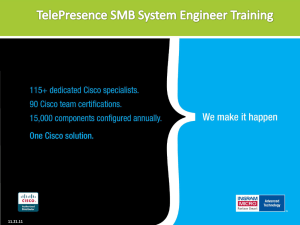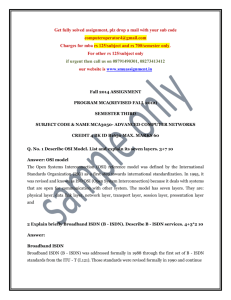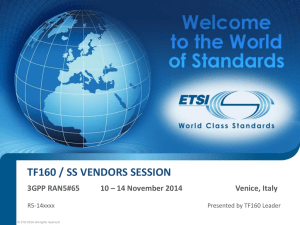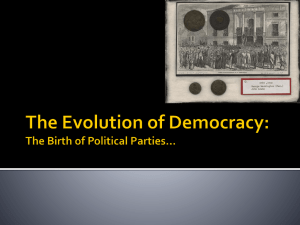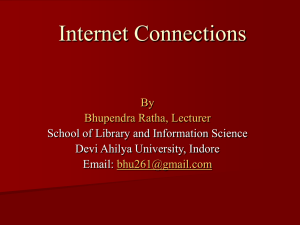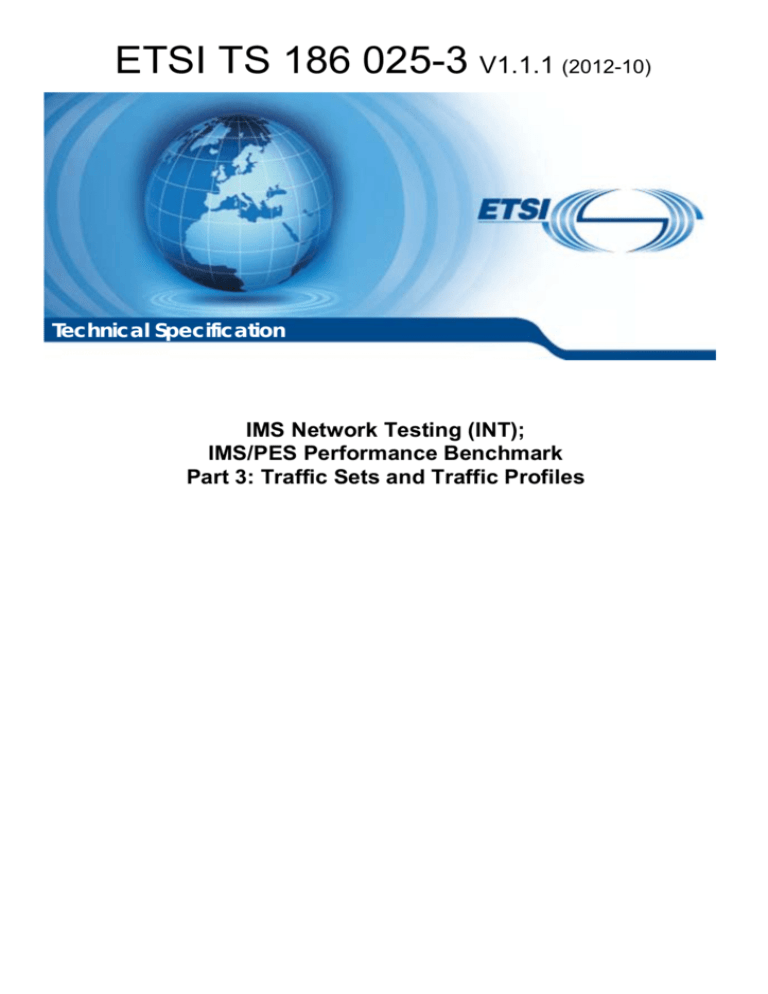
ETSI TS 186 025-3 V1.1.1 (2012-10)
Technical Specification
IMS Network Testing (INT);
IMS/PES Performance Benchmark
Part 3: Traffic Sets and Traffic Profiles
2
ETSI TS 186 025-3 V1.1.1 (2012-10)
Reference
DTS/INT-00078-3
Keywords
IMS, ISDN, PSTN, performance
ETSI
650 Route des Lucioles
F-06921 Sophia Antipolis Cedex - FRANCE
Tel.: +33 4 92 94 42 00 Fax: +33 4 93 65 47 16
Siret N° 348 623 562 00017 - NAF 742 C
Association à but non lucratif enregistrée à la
Sous-Préfecture de Grasse (06) N° 7803/88
Important notice
Individual copies of the present document can be downloaded from:
http://www.etsi.org
The present document may be made available in more than one electronic version or in print. In any case of existing or
perceived difference in contents between such versions, the reference version is the Portable Document Format (PDF).
In case of dispute, the reference shall be the printing on ETSI printers of the PDF version kept on a specific network drive
within ETSI Secretariat.
Users of the present document should be aware that the document may be subject to revision or change of status.
Information on the current status of this and other ETSI documents is available at
http://portal.etsi.org/tb/status/status.asp
If you find errors in the present document, please send your comment to one of the following services:
http://portal.etsi.org/chaircor/ETSI_support.asp
Copyright Notification
No part may be reproduced except as authorized by written permission.
The copyright and the foregoing restriction extend to reproduction in all media.
© European Telecommunications Standards Institute 2012.
All rights reserved.
TM
TM
TM
DECT , PLUGTESTS , UMTS and the ETSI logo are Trade Marks of ETSI registered for the benefit of its Members.
TM
3GPP and LTE™ are Trade Marks of ETSI registered for the benefit of its Members and
of the 3GPP Organizational Partners.
GSM® and the GSM logo are Trade Marks registered and owned by the GSM Association.
ETSI
3
ETSI TS 186 025-3 V1.1.1 (2012-10)
Contents
Intellectual Property Rights ................................................................................................................................4
Foreword.............................................................................................................................................................4
1
Scope ........................................................................................................................................................5
2
References ................................................................................................................................................5
2.1
2.2
3
3.1
3.2
4
4.1
4.1.1
4.1.2
4.1.3
4.1.4
4.1.5
4.1.6
4.1.7
4.1.8
4.1.9
4.2
4.2.1
4.2.2
Normative references ......................................................................................................................................... 5
Informative references ........................................................................................................................................ 5
Definitions and abbreviations ...................................................................................................................6
Definitions .......................................................................................................................................................... 6
Abbreviations ..................................................................................................................................................... 6
Initial benchmark traffic set and traffic-time profile ................................................................................6
Initial benchmark traffic-time profile ................................................................................................................. 7
MSAN 500 PSTN users ................................................................................................................................ 8
MSAN 500 POTS/ISDN mixed users........................................................................................................... 8
MSAN 500 POTS/ISDN mixed users with data traffic ................................................................................ 9
MSAN with 500 ISDN subscribers (2 lines) .............................................................................................. 11
MSAN with 1 000 analog subscribers ........................................................................................................ 11
MSAN / TRUNKING MGW with 16 PRA ................................................................................................ 11
MSAN/TRUNKING MGW with 16 PRA mixed users with data traffic .................................................... 11
Load A = 0,2 CAPS 4.1.8 MSAN/TRUNKING MGW with 100 PRA ...................................................... 12
MSAN/TRUNKING MGW with 1024 PRA .............................................................................................. 12
Initial benchmark traffic set.............................................................................................................................. 14
ISDN/PSTN mixed initial benchmark traffic set ........................................................................................ 14
PSTN initial benchmark traffic set ............................................................................................................. 18
History ..............................................................................................................................................................19
ETSI
4
ETSI TS 186 025-3 V1.1.1 (2012-10)
Intellectual Property Rights
IPRs essential or potentially essential to the present document may have been declared to ETSI. The information
pertaining to these essential IPRs, if any, is publicly available for ETSI members and non-members, and can be found
in ETSI SR 000 314: "Intellectual Property Rights (IPRs); Essential, or potentially Essential, IPRs notified to ETSI in
respect of ETSI standards", which is available from the ETSI Secretariat. Latest updates are available on the ETSI Web
server (http://ipr.etsi.org).
Pursuant to the ETSI IPR Policy, no investigation, including IPR searches, has been carried out by ETSI. No guarantee
can be given as to the existence of other IPRs not referenced in ETSI SR 000 314 (or the updates on the ETSI Web
server) which are, or may be, or may become, essential to the present document.
Foreword
This Technical Specification (TS) has been produced by ETSI Technical Committee IMS Network Testing (INT).
The present document is part 3 of a multi-part deliverable covering the IMS/PES Performance Benchmark, as identified
below:
Part 1:
"Core Concepts";
Part 2:
"Subsystem Configurations and Benchmarks";
Part 3:
"Traffic Sets and Traffic Profiles";
Part 4:
"Reference Load network quality parameters".
ETSI
5
1
ETSI TS 186 025-3 V1.1.1 (2012-10)
Scope
The present document is for an initial release of an IMS/PES performance benchmark. The same tests can be used also
for legacy PSTN/ISDN networks or for inter-working tests between PSTN/ISDN emulation subsystem and legacy
PSTN and ISDN. The metrics measured and reported are for performance of this subsystem under a communications
application load.
The present document is the third part of the multi-part deliverable which consists of four parts.
TS 186 025-1 [1] contains the overall benchmark descriptions, architectures, processes, and information models that are
common to all specific benchmarking scenarios.
TS 186 025-2 [2] contains the specific benchmarking use-cases and scenarios, along with scenario specific metrics and
design objectives. It also defines the SUT configuration parameters. This part also contains any required extensions to
the overall descriptions present in the present document, if necessary for the specific scenario.
The present document defines an initial benchmark test through the specification of a traffic set, traffic-time
profile and benchmark test procedure.
TS 186 025-4 [3] defines Reference Load network quality parameters for the use cases defined in the present document.
2
References
References are either specific (identified by date of publication and/or edition number or version number) or
non-specific. For specific references, only the cited version applies. For non-specific references, the latest version of the
reference document (including any amendments) applies.
Referenced documents which are not found to be publicly available in the expected location might be found at
http://docbox.etsi.org/Reference.
NOTE:
2.1
While any hyperlinks included in this clause were valid at the time of publication, ETSI cannot guarantee
their long term validity.
Normative references
The following referenced documents are necessary for the application of the present document.
[1]
ETSI TS 186 025-1: "Telecommunications and Internet converged Services and Protocols for
Advanced Networking (TISPAN); IMS/PES Performance Benchmark Part 1: Core Concepts".
[2]
ETSI TS 186 025-2 (V2.2.1): "Telecommunications and Internet converged Services and Protocols
for Advanced Networking (TISPAN);IMS/PES Performance Benchmark; Part 2: Subsystem
Configurations and Benchmarks".
[3]
ETSI TS 186 025-4 (V2.1.1): "Telecommunications and Internet Converged Services and
Protocols for Advanced Networking (TISPAN); IMS/PES Performance Benchmark;
Part 4: Reference Load network quality parameters".
2.2
Informative references
The following referenced documents are not necessary for the application of the present document but they assist the
user with regard to a particular subject area.
[i.1]
ITU-T Recommendation T.30 (2005): "Procedures for document facsimile transmission in the
general switched telephone network".
[i.2]
ITU-T Recommendation T.4 (2003): "Standardization of Group 3 facsimile terminals for
document transmission".
ETSI
6
ETSI TS 186 025-3 V1.1.1 (2012-10)
[i.3]
ITU-T Recommendation T.24 (1998): "Standardized digitized image set".
[i.4]
ITU-T Recommendation Q.543 (1993): "Digital exchange performance objective".
3
Definitions and abbreviations
3.1
Definitions
For the purposes of the present document, the following terms and definitions apply:
Reference load A: intended to represent the normal upper mean level of activity which Administrations would wish to
provide for on customer lines and inter-exchange activities
Reference load B: intended to represent an increased level beyond normal planned activity levels
3.2
Abbreviations
For the purposes of the present document, the following abbreviations apply:
BA
BC
BHCA
CAPS
Erl
IMS
ISDN
ISUP
MGC
MGW
MHT
MSAN
NGN
PES
NOTE:
PI
PRA
PSTN
s
SIP
SIP-I
SUT
tm
UDI
VBD
4
ISDN Basic Access
Bearer Capability
Busy Hour Call Attempts
Call Attempts Per Second
Erlang
IP Multimedia Subsystem
Integrated Services Digital Network
ISDN User Part
Media Gate way Controller
Media Gate Way
Mean Holding Time
Multi-Service Access Node
Next Generation Networks
PSTN Emulation Solution
http://www.utstar.com/files/1647.pdf
Progress Indicator
ISDN Primary Access
Public Switched Telecommunications Network
second
Session Initiation Protocol
SIP with encapsulated ISUP
System Under Test
Mean holding time for originating traffic
Unrestricted Digital Information
Voice Band Data
Initial benchmark traffic set and traffic-time profile
This clause defines the load profiles to simulate ISDN - non-ISDN environments. The data used in this traffic -time
profile are based on profiles from Austria and Germany.
ETSI
7
4.1
ETSI TS 186 025-3 V1.1.1 (2012-10)
Initial benchmark traffic-time profile
Following assumptions are valid for the calculations:
The required call processing capacity depends on the number of calls offered to the exchange. The basic formula to
calculate the required BHCA is:
BHCA = A × 3 600 / tm
A = traffic for Reference load A [i.4]
tm = mean holding time
Access Types
POTS
ISDN-BA
Traffic per subscriber
[Erl]
A = number of
subscribers ×
originating traffic per
subscriber
0.02
0,050
0,100
0,5
15
0,800
BHCA
(BHCA =
A × 3 600 / tm)
CAPS
(BHCA/3600)
Summary
0,72 (1,2 Note)
0,0002
B-Channel
1,80 (2 Note)
0,0005
Summary
3,60
0,0010
ISDN-PRA
B-Channel
18
0,005
Summary
540
0,15
ISUP-Trunk
Channel
28,80
0,0080
utilization
Summary
24,000
864,00
0,2400
NOTE:
The values in brackets are values proposed in ITU-T Recommendation Q.543 [i.4].
mean holding time [s]
100
100
100
100
Traffic distribution of originating traffic:
Transit solution
25 %
Intra-MGW
50 %
Inter-MGW
25 %
Inter-domain (SIP-I)
Relation between Voice and Data Traffic Types
Voice/VBD
90:10
Relation between fax, data and
90:5:5
text modem types
Voice/UDI
99:1
Figure 1: Relation between Voice and Voice Band Data (VBD) Traffic Types
ETSI
8
ETSI TS 186 025-3 V1.1.1 (2012-10)
Figure 2: Relation between data modem types
4.1.1
MSAN 500 PSTN users
•
Local exchange with 500 analog subscribers
•
Originating BHCA
•
A = number of subscribers × originating traffic per subscriber = 500 × 0,02 = 10 Erl
•
tm = mean holding time for originating traffic = 100 s
•
BHCA = 360
•
Load A = 0,1 CAPS
Table 1: MGW Traffic Load for 500 POTS subscriber
Type of Call
Intra-MGW
Inter-MGW
Inter-domain
Total
4.1.2
Traffic mix
Traffic (Erl)
25 %
50 %
25 %
100 %
2,5
5
2,5
10
MSAN 500 POTS/ISDN mixed users
•
100 % Voice Traffic
•
333 POTS Lines
•
166 ISDN Lines
ETSI
cps
0,025
0,05
0,025
0,1
9
ETSI TS 186 025-3 V1.1.1 (2012-10)
POTS:
-
Local exchange with 333 analog subscribers
-
Originating BHCA
-
A = number of subscribers × originating traffic per subscriber = 333 × 0,02 = 6,66 Erl
-
tm = mean holding time for originating traffic = 100 s
-
BHCA = 240
-
Load A = 0,067 CAPS
Type of Call
Intra-MGW
Inter-MGW
Inter-domain
Total
Traffic mix
Traffic (Erl)
25 %
50 %
25 %
100 %
1,66
3,33
1,66
6,67
cps
0,016
0,033
0,016
0,066
ISDN:
-
MSAN with 166 ISDN subscribers (2 lines per subscriber =332 lines) Originating BHCA
-
A = number of subscribers × originating traffic per ISDN subscriber (2 lines)= 166 × 0,10 = 16,6 Erl
-
tm = mean holding time for originating traffic = 100 s
-
BHCA = 597
-
Load A = 0,166 CAPS
Type of Call
Intra-MGW
Inter-MGW
Inter-domain
Total
4.1.3
Traffic mix
Traffic (Erl)
25 %
50 %
25 %
100%
4,15
8,3
4,15
16,6
Cps
0,042
0,083
0,042
0,166
MSAN 500 POTS/ISDN mixed users with data traffic
•
90 % Voice Traffic
•
9 % Fax /Modem Traffic
•
1 % Data ISDN Traffic
•
333 POTS Lines
•
166 ISDN Lines
POTS: Voice
-
Local exchange with 300 analog subscribers
-
Originating BHCA
-
A = number of subscribers × originating traffic per subscriber = 300 × 0,02 = 6 Erl
-
tm = mean holding time for originating traffic = 100 s
-
BHCA = 216 BHCA
-
Load A = 0,06 CAPS
ETSI
10
Type of Call
ETSI TS 186 025-3 V1.1.1 (2012-10)
Traffic mix
Traffic (Erl)
25 %
50 %
25 %
100 %
1,5
3
1,5
6
Intra-MGW
Inter-MGW
Inter-domain
Total
Cps
0,083
0,166
0,083
0,06
POTS: VBD Data
-
Local exchange with 33 analog subscribers (10 % of voice traffic)
-
Originating BHCA
-
A = number of subscribers × originating traffic per subscriber = 33 × 0,02 = 0,66 Erl
-
tm = mean holding time for originating traffic = 120 s (2 pages Horizontal: 200 or 204 scan lines per
inch;
-
Vertical: 200 or 196 scan lines per inch ('Fine') (see note in clause 4.1.9)
-
BHCA = 0,66 × 3 600 / 120 = 19,8 BHCA
-
Load A = 0,0055 CAPS
ISDN: Voice
-
MSAN with 163 ISDN subscribers (2 lines per subscriber =326 lines) Originating BHCA
-
A = number of subscribers × originating traffic per ISDN subscriber (2 lines)= 163 × 0,1 = 16,3 Erl
-
tm = mean holding time for originating traffic = 100 s
-
BHCA = 586,8
-
Load A = 0,163 CAPS
Type of Call
Traffic mix
Traffic (Erl)
25 %
50 %
25 %
100%
4,075
8,15
4,075
16,3
Intra-MGW
Inter-MGW
Inter-domain
Total
Cps
0,04
0,0815
0,04
0,163
ISDN: VBD Data
-
Local exchange with 2 VBD subscribers (10 % of voice traffic)
-
Originating BHCA
-
A = number of subscribers × originating traffic per ISDN subscriber (2 lines) = 2 × 0,1 = 0,2 Erl
-
tm = mean holding time for originating traffic = 120 s (2 pages Horizontal: 200 or 204 scan lines per
inch; Vertical: 200 or 196 scan lines per inch ('Fine') (see note in clause 4.1.9)
-
BHCA = 0,2 × 3 600 / 120 = 6 BHCA
-
Load A = 0,0016 CAPS
ISDN: Data 64 Kbit/s; MSAN with 2 ISDN subscribers
-
2 parallel channels (2xBA)
-
tm = mean holding time for originating traffic = 500 s
-
BHCA= 0,27
ETSI
11
-
4.1.4
ETSI TS 186 025-3 V1.1.1 (2012-10)
Load A = 2 CAPS
MSAN with 500 ISDN subscribers (2 lines)
•
100 % Voice Traffic
•
A = number of subscribers × originating traffic per ISDN subscriber (2 lines)= 500 × 0,1 = 50 Erl
•
tm = mean holding time for originating traffic = 100 s
•
BHCA = 1 800 BHCA
•
Load A = 0,5 CAPS
Type of Call
Intra-MGW
Inter-MGW
Inter-domain
Total
4.1.5
Traffic mix
Traffic (Erl)
25 %
50 %
25 %
100 %
25
50
25
50
Cps
0,125
0,25
0,125
0,5
MSAN with 1 000 analog subscribers
•
100 % Voice Traffic
•
A = number of subscribers × originating traffic per subscriber = 1 000 × 0,02 = 20 Erl
•
tm = mean holding time for originating traffic = 100 s
•
BHCA = 20 × 3 600 / 100 = 720 BHCA
•
Load A = 0,2 CAPS
Type of Call
Intra-MGW
Inter-MGW
Inter-domain
Total
4.1.6
Traffic mix
Traffic (Erl)
25 %
50 %
25 %
100 %
5
10
5
20
Cps
0,05
0,1
0,05
0,2
MSAN / TRUNKING MGW with 16 PRA
•
100 % Voice Traffic
•
A = number of subscribers × originating traffic per subscriber = 480 × 0,5 = 240 Erl
•
BHCA = 480 × 18 = 8 640
•
Load A = 480 x 0,005= 2,4 CAPS
4.1.7
MSAN/TRUNKING MGW with 16 PRA mixed users with data traffic
•
90 % Voice Traffic
•
10 % Fax /Modem Traffic
ISDN PRA: Voice
-
A = number of channels × originating traffic per ISDN PRA channel = 432 × 0,5 = 216 Erl
-
BHCA = 432 x 18 = 7 776
ETSI
12
-
ETSI TS 186 025-3 V1.1.1 (2012-10)
Load A = 432 x 0,005= 2,16 CAPS
ISDN PRA VBD Data
-
Local exchange with 48 analog subscribers (10 % of voice traffic)
-
A = number of channels × originating traffic per ISDN PRA channel = 48 × 0,5 = 24 Erl
-
tm = mean holding time for originating traffic = 120 s (2 pages Horizontal: 200 or 204 scan lines per
inch;
-
Vertical: 200 or 196 scan lines per inch ('Fine') (see note in clause 4.1.9)
-
BHCA = 24 × 3 600 / 120 = 720 BHCA
4.1.8
Load A = 0,2 CAPS 4.1.8 MSAN/TRUNKING MGW with 100 PRA
•
100 % Voice Traffic
•
A = number of channels × originating traffic per ISDN PRA channel = 3 000 × 0,5 = 1 500 Erl
•
BHCA = 3 000 × 18 = 54 000
•
Load A = 3 000 x 0,005= 15 CAPS
4.1.9
MSAN/TRUNKING MGW with 1024 PRA
•
100 % Voice Traffic
•
A = number of channels × originating traffic per ISDN PRA channel = 30 720 × 0,5 = 15 360 Erl
•
BHCA = 30 720 × 18 = 552 960
•
Load A = 30 720 x 0,005= 154 CAPS
NOTE:
Group 3 faxes conform to the ITU-T Recommendations T.30 [i.1] and T.4 [i.2]. The horizontal and
vertical resolutions are allowed by the T.4 [i.2] standard to vary among a set of fixed resolutions:
Horizontal: 100 scan lines per inch:
-
Vertical: 100 scan lines per inch
Horizontal: 200 or 204 scan lines per inch:
-
Vertical: 100 or 98 scan lines per inch ('Standard')
-
Vertical: 200 or 196 scan lines per inch ('Fine')
-
Vertical: 400 or 391 (note not 392) scan lines per inch ('Superfine')
Horizontal: 300 scan lines per inch:
-
Vertical: 300 scan lines per inch
Horizontal: 400 or 408 scan lines per inch:
-
Vertical: 400 or 391 scan lines per inch ('Ultrafine')
ETSI
13
ETSI TS 186 025-3 V1.1.1 (2012-10)
Figure 3: Test Pattern Facsimile Test Chart BW01 [i.3]
ETSI
14
ETSI TS 186 025-3 V1.1.1 (2012-10)
4.2
Initial benchmark traffic set
4.2.1
ISDN/PSTN mixed initial benchmark traffic set
Use Case Section
Test Scenario
Scenario ID
TS 186 025-2 [2],
TS 186 025-2 [2], clause 5.1.1.1
clause 5.1: Session ISDN - ISDN Scenario 1.1 Basic call with BC=
Set-Up/
speech - enblock sending
ISDN-ISDN
Use-Case 1
TS 186 025-2 [2], clause 5.1.1.2
ISDN - ISDN Scenario 1.2 Basic call with BC=
speech - enblock sending
I_ I_S_1.1
TS 186 025-2 [2], clause 5.1.1.3
ISDN - ISDN Scenario 1.3 Basic call - overlap
sending with BC= speech
I_ I_S_1.3
TS 186 025-2 [2], clause 5.1.1.4
ISDN - ISDN Scenario 1.4
Basic call with BC= 3,1 KHz audio - Fax with
33,6 kbit/s
I_ I_S_1.4
TS 186 025-2 [2], clause 5.1.1.5
ISDN - ISDN Scenario 1.5
Basic call with BC= 3,1 KHz audio - Fax with
14,4 kbit/s
I_ I_S_1.5
TS 186 025-2 [2], clause 5.1.1.6
ISDN - ISDN Scenario 1.6
Basic call with BC= 3,1 kHz with PI#3
I_ I_S_1.6
TS 186 025-2 [2], clause 5.1.1.7
ISDN - ISDN Scenario 1.7
Basic call with BC= 3,1 kHz with PI#3
I_ I_S_1.7
TS 186 025-2 [2], clause 5.1.1.8
ISDN - ISDN Scenario 1.8
Basic call with BC= 3,1 kHz - Modem V.32 bis
(4,8 kbit/s, 9,6 kbit/s, 14,4 kbit/s)
I_ I_S_1.8
TS 186 025-2 [2], clause 5.1.1.9
ISDN - ISDN Scenario 1.9
Basic call with BC= 3,1 kHz - Modem V.34 (up
to 33,6 kbit/s)
I_ I_S_1.9
ETSI
I_ I_S_1.2
Scenario
Scenario
% of
Arrival
System Distribution
Load
10 %
Poisson,
mean
selected by
traffic-time
profile
10 %
Poisson,
mean
selected by
traffic-time
profile
9%
Poisson,
mean
selected by
traffic-time
profile
2,25 %
Poisson,
mean
selected by
traffic-time
profile
2,25 %
Poisson,
mean
selected by
traffic-time
profile
30 %
Poisson,
mean
selected by
traffic-time
profile
30 %
Poisson,
mean
selected by
traffic-time
profile
2,25 %
Poisson,
mean
selected by
traffic-time
profile
2,25 %
Poisson,
mean
selected by
traffic-time
profile
15
Use Case Section
Test Scenario
ETSI TS 186 025-3 V1.1.1 (2012-10)
Scenario ID
TS 186 025-2 [2],
TS 186 025-2 [2], clause 5.1.1.10
clause 5.1: Session ISDN - ISDN Scenario 1.10
Set-Up/
Basic call with BC= UDI - enblock sending
ISDN-ISDN
Use-Case 1
TS 186 025-2 [2], clause 5.1.1.11
ISDN - ISDN Scenario 1.11
Basic call with BC= UDI - enblock sending
I_ I_S_1.10
I_ I_S_1.11
TS 186 025-2 [2], clause 5.1.1.12
ISDN - ISDN Scenario 1.12
called user is user determined user busy
I_ I_S_1.12
TS 186 025-2 [2], clause 5.1.1.13
ISDN - ISDN Scenario 1.13
No answer from the called user
I_ I_S_1.13
ETSI
Scenario
Scenario
% of
Arrival
System Distribution
Load
0,5 %
Poisson,
mean
selected by
traffic-time
profile
0,5 %
Poisson,
mean
selected by
traffic-time
profile
0,5 %
Poisson,
mean
selected by
traffic-time
profile
0,5 %
Poisson,
mean
selected by
traffic-time
profile
16
ETSI TS 186 025-3 V1.1.1 (2012-10)
Use Case Section
Test Scenario
Scenario ID
TS 186 025-2 [2],
clause 5.1: Session
Set-Up/
ISDN-PSTN
Use-Case 2
(in combination
with use case 3)
TS 186 025-2 [2], clause 5.1.2.1
ISDN - PSTN Scenario 2.1 Basic call with BC=
speech - enblock sending
I_ P_S_2.1
TS 186 025-2 [2], clause 5.1.2.2
ISDN - PSTN Scenario 2.2 Basic call with BC=
speech - enblock sending
I_ P_S_2.2
TS 186 025-2 [2], clause 5.1.2.3
ISDN - PSTN Scenario 2.3 Basic call - overlap
sending with BC= speech
I_ P_S_2.3
TS 186 025-2 [2], clause 5.1.2.4
ISDN - PSTN Scenario 2.4
Basic call with BC= 3,1 KHz audio - Fax with
33,6 kbit/s
I_ P_S_2.4
TS 186 025-2 [2], clause 5.1.2.5 ISDN PSTN Scenario 2.5
Basic call with BC= 3,1 KHz audio - Fax with
14,4 kbit/s
I_ P_S_2.5
TS 186 025-2 [2], clause 5.1.2.6
ISDN - PSTN Scenario 2.6
Basic call with BC= 3,1 kHz - Modem V.32 bis
(4,8 kbit/s, 9,6 kbit/s 14,4 kbit/s)
I_ P_S_2.6
TS 186 025-2 [2], clause 5.1.2.7
ISDN - PSTN Scenario 2.7
Basic call with BC= 3,1 kHz - Modem V.34 (up
to 33,6 kbit/s)
I_ P_S_2.7
TS 186 025-2 [2], clause 5.1.2.8
ISDN - PSTN Scenario 2.8
called user is user determined user busy
I_ P_S_2.8
TS 186 025-2 [2], clause 5.1.2.9
ISDN - PSTN Scenario 2.9
No answer from the called user
I_ P_S_2.9
ETSI
Scenario
Scenario
% of
Arrival
System Distribution
Load
15 %
Poisson,
mean
selected by
traffic-time
profile
15 %
Poisson,
mean
selected by
traffic-time
profile
14 %
Poisson,
mean
selected by
traffic-time
profile
2,25 %
Poisson,
mean
selected by
traffic-time
profile
2,25 %
Poisson,
mean
selected by
traffic-time
profile
0,25 %
Poisson,
mean
selected by
traffic-time
profile
0,25 %
Poisson,
mean
selected by
traffic-time
profile
0,5 %
Poisson,
mean
selected by
traffic-time
profile
0,5 %
Poisson,
mean
selected by
traffic-time
profile
17
ETSI TS 186 025-3 V1.1.1 (2012-10)
Use Case Section
Test Scenario
Scenario ID
TS 186 025-2 [2],
clause 5.1: Session
Set-Up/
PSTN- ISDN
Use-Case 3
(in combination
with use case 2)
TS 186 025-2 [2], clause 5.1.3.1
PSTN - ISDN Scenario 3.1
Basic call. The call is released from the calling
user
P_I_S_3.1
TS 186 025-2 [2], clause 5.1.3.2
PSTN - ISDN Scenario 3.2 Basic call
The call is released from the called user
P_I_S_3.2
TS 186 025-2 [2], clause 5.1.3.3
PSTN - ISDN Scenario 3.3
Basic call with BC= 3,1 KHz audio - Fax with
33,6 kbit/s
P_I_S_3.3
TS 186 025-2 [2], clause 5.1.3.4
PSTN - ISDN Scenario 3.4
Basic call with BC= 3,1 KHz audio - Fax with
14,4 kbit/s
P_I_S_3.4
TS 186 025-2 [2], clause 5.1.3.5
PSTN - ISDN Scenario 3.5
Basic call with BC= 3,1 KHz audio - Modem
V.90
P_I_S_3.5
TS 186 025-2 [2], clause 5.1.3.6
PSTN - ISDN Scenario 3.6
called user is user determined user busy
P_I_S_3.6
TS 186 025-2 [2], clause 5.1.3.7
PSTN - ISDN Scenario 3.7 - no answer from
the called user
P_I_S_3.7
ETSI
Scenario
Scenario
% of
Arrival
System Distribution
Load
22 %
Poisson,
mean
selected by
traffic-time
profile
22 %
Poisson,
mean
selected by
traffic-time
profile
2,25 %
Poisson,
mean
selected by
traffic-time
profile
2,25 %
Poisson,
mean
selected by
traffic-time
profile
0,5 %
Poisson,
mean
selected by
traffic-time
profile
0,5 %
Poisson,
mean
selected by
traffic-time
profile
0,5 %
Poisson,
mean
selected by
traffic-time
profile
18
4.2.2
ETSI TS 186 025-3 V1.1.1 (2012-10)
PSTN initial benchmark traffic set
Use Case
Section
Test Scenario
Scenario ID
TS 186 025-2 [2],
clause 5.1:
Session Set-Up/
PSTN- PSTN
Use-Case 4
TS 186 025-2 [2], clause 5.1.4.1
PSTN - ISDN Scenario 4.1
Basic call. The call is released from the calling
user
TS 186 025-2 [2], clause 5.1.4.2
PSTN – PSTN Scenario 4.2 Basic call
The call is released from the called user
TS 186 025-2 [2], clause 5.1.4.3
PSTN - PSTN Scenario 4.3
Basic call with BC= 3,1 KHz audio - Fax with
33,6 kbit/s
TS 186 025-2 [2], clause 5.1.4.4
PSTN - PSTN Scenario 4.4
Basic call with BC= 3,1 KHz audio - Fax with
14,4 kbit/s
TS 186 025-2 [2], clause 5.1.4.5
PSTN - PSTN Scenario 4.5
Basic call with BC= 3,1 KHz audio - Modem
V.34 (up to 33,6 kbit/s)
TS 186 025-2 [2], clause 5.1.4.6
PSTN - PSTN Scenario 4.6
Basic call with BC= 3,1 KHz audio - Modem
V.32 bis (4,8 kbit/s, 9,6 kbit/s, 14,4 kbit/s)
TS 186 025-2 [2], clause 5.1.4.7
PSTN - PSTN Scenario 4.7
Called user is user busy
TS 186 025-2 [2], clause 5.1.4.8
PSTN - ISDN Scenario 4.8
no answer from the called user
P_P_S_4.1
Scenario %
of System
Load
44,5 %
P_P_S_4.2
44,5 %
P_P_S_4.3
4,5 %
P_P_S_4.4
4,5 %
P_P_S_4.5
0,5 %
P_P_S_4.6
0,5 %
P_P_S_4.7
0,5 %
P_P_S_4.8
0,5 %
ETSI
Type
Scenario
Arrival
Distribution
19
History
Document history
V1.1.1
October 2012
Publication
ETSI
ETSI TS 186 025-3 V1.1.1 (2012-10)

